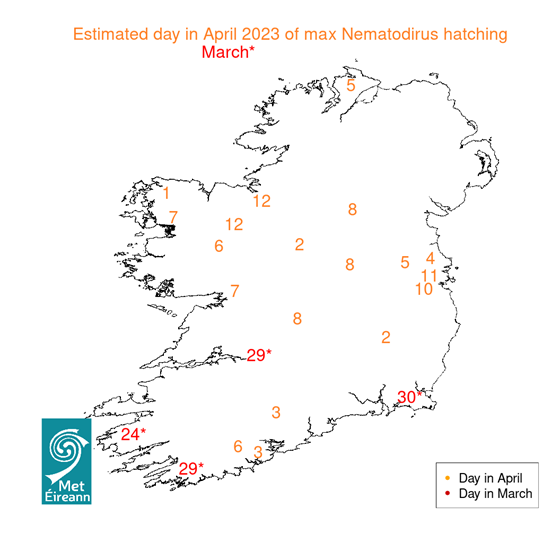Taken from the Department of Agriculture, Food and the Marine (DAFM) Press Release on gov.ie .
Introduction
Each spring, the Department of Agriculture, Food and the Marine (DAFM), in collaboration with Met Éireann, UCD and Teagasc advises farmers of the predicted risk of disease, chiefly in lambs, caused by the roundworm Nematodirus battus.
The Disease
Nematodirosis is a severe parasitic disease of lambs 6 to 12 weeks of age which become infected by ingesting large numbers of infective larvae from grazing on contaminated pasture. The life cycle of N. battus is unlike that of other roundworms in that eggs deposited on pasture do not hatch until the following year to release the infective larvae. This happens during a mass hatching event in spring when soil temperatures increase after a period of cold weather. Disease typically occurs in April, May and June.
After ingestion by lambs, Nematodirus larvae invade the wall of the intestine. Disease is characterised by profuse diarrhoea, dehydration and weight loss. Calves may also be similarly affected. In outbreak scenarios, lambs can be seen congregating around water troughs due to the severe thirst that develops. Adult sheep are unaffected by the parasite.
How to prevent disease
This disease is best prevented by keeping the current year’s lambs off any pasture that was grazed by lambs or young calves (which can be carriers of infection) in the previous year. Enterprises with high stocking rates are particularly vulnerable. Please note that twin lambs, or single lambs born to ewes of poor milking ability may be at a greater risk of developing the disease as they begin consuming greater amounts of grass earlier in life. If ‘clean’ pasture is available, preference should be given to moving these lambs first.
When peak egg hatching is predicted to occur this year
The maximum Nematodirus egg hatching is expected this year to peak from the end of March to the early days of April in the south and Atlantic coastal fringes. In the east, midlands and inland areas of the northwest it will be slightly later, with peak egg hatching generally occurring from 6-12 April. Please see the map below for expected timing of peaks in Nematodirus egg hatching on pasture.
When lambs should be treated
At-risk lambs (that is, typically 6 to 12 weeks of age and grazing on contaminated pasture) should be treated approximately two weeks after the peak of Nematodirus egg hatching.
However, consideration should be given to dosing lambs earlier on individual farms where clinical signs consistent with Nematodirus are observed, as the above treatment guidelines are based on estimated peak hatching of eggs.
